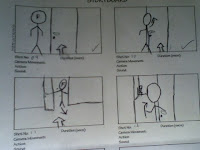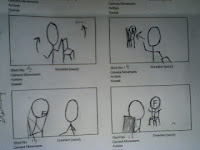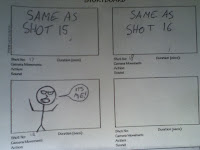Continuity task involving filming and editing a character sitting down opposite another character with whom he/ she exchanges a couple of lines of dialogue. This task should demonstrate match on action, shot/reverse shot and the 180 degree rule.
Planning
Below is our storyboard. This helped our planning so that we wouldn't miss any camera shots out. It also sped up the editing stage because we knew the order in which to put the shots in. We didn't stick to this story board because we felt we could improve our film by changing the sequence and
adding more camera shots.
It is set in a school and there is panic because there is an unknown murderer in the school and someone is running around the school looking for survivors - he is the protagonist. He checks several rooms until he finds s mysterious person in the corner. The audience first impression that he is scared and vulnerable but as the conversation starts they should doubt this and then realise that he is the murderer. We tried to make the ending as shocking as possible and the music helps this.
 In this first shot we are introduced to the the person running. We used a wide shot to show the setting. This cuts to a high shot of another person looking vulnerable. It then cuts a close up to show his emotions. At this point the audience are confused to who this is. This cuts to another shot the runner.
In this first shot we are introduced to the the person running. We used a wide shot to show the setting. This cuts to a high shot of another person looking vulnerable. It then cuts a close up to show his emotions. At this point the audience are confused to who this is. This cuts to another shot the runner.

The runner finally finds the the mysterious person and the music stops. Tension is released as the audience think the characters are safe. Again a variety of camera shots could have improved this scene.
 Te camera pans away from the person in the corner to follow the runner getting a chair. This camera shot didn't quite work because it took the attention off the mysterious character. The series of questions that follow show the runners intentions and that he is the protagonist.
Te camera pans away from the person in the corner to follow the runner getting a chair. This camera shot didn't quite work because it took the attention off the mysterious character. The series of questions that follow show the runners intentions and that he is the protagonist. 
In the last shot all is revealed as the mysterious person attacks the runner showing that he is the antagonist. We used a point of view shot to emphasise the shock.
We also wrote a risk assessment for the actors so they had full knowledge of the risks that they might take. The next step was filming. This was quite tricky and a lengthy process because it was our first experience of filming and acting. We shot at various locations around school and this made it difficult to get the continuity right but I could only spot one small mistake.
Our next task was to start editing. I was trusted to obtain suitable music which had a high tempo with a spooky tone and I think the music goes well with the theme and shots. The editing process did take a lot of time however it was something we full well knew before we started. A few lessons later we had finished and the the group and In were very happy with all our work.
Individual Performance
I feel I worked very well as part of the team. When we had been set the brief I came up with multiple ideas but not only that but took on board the groups ideas and took good bits from the two. I think I understood our theme well which allowed me to make a good music choice to go on in the background in the running scenes. I was committed to completing the project to a good standard and because of this gave up my free time. There were times when I could have been more professional to get the filming done quicker but in the end I don't think this affected the final piece. I found the editing tricky and because of this maybe I didn't throw myself into that with enthusiasm so that is something I can improve
Group Performance
We worked well together as a group, especially coming up with ideas in the initial stages because we listened to each other and took good points from everyone. We shared out our responsibilities evenly and this helped us get on well I think. When it came to the filming I think we could have been more professional but we did manage to get all our shots done. One issue was that we only needed one person to operate the camera and the other two were actors so the other person was a bit distracting but I'm mentioning no names. In the editing process we all contributed to ideas and we came up with a professional final edit.












